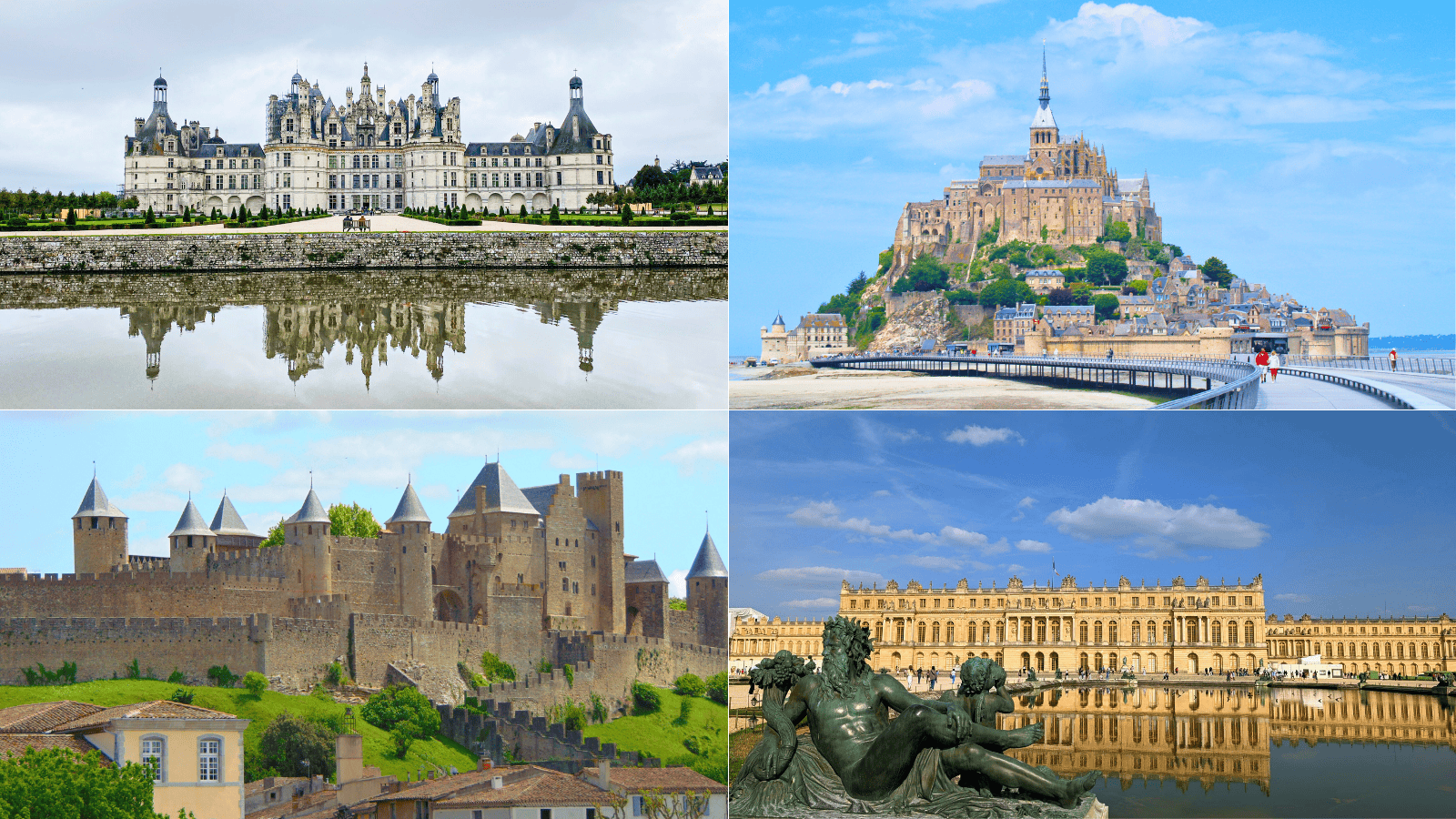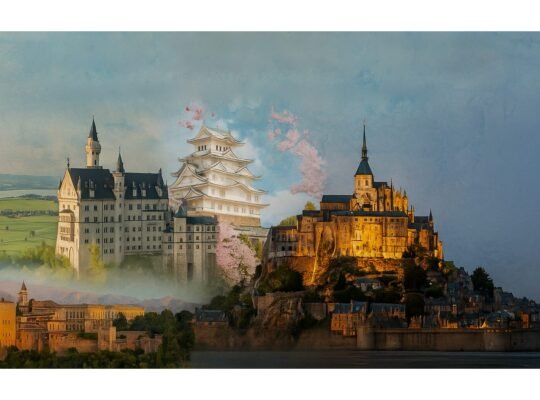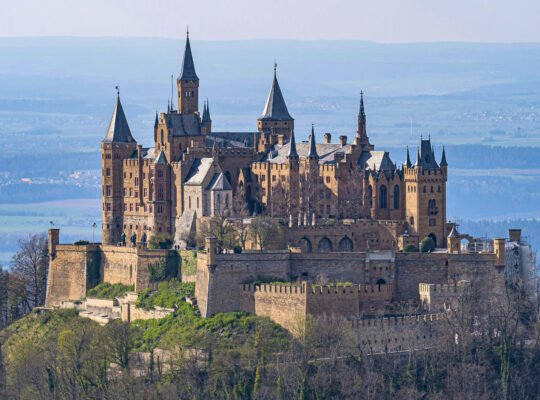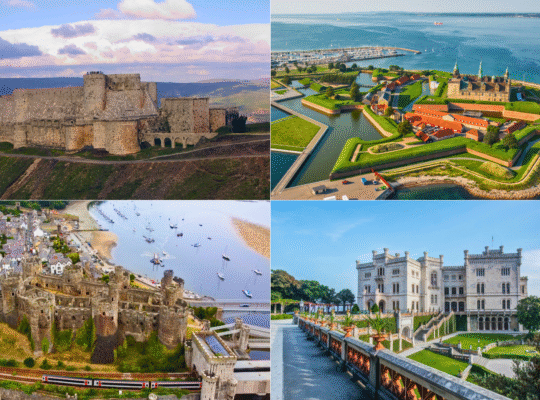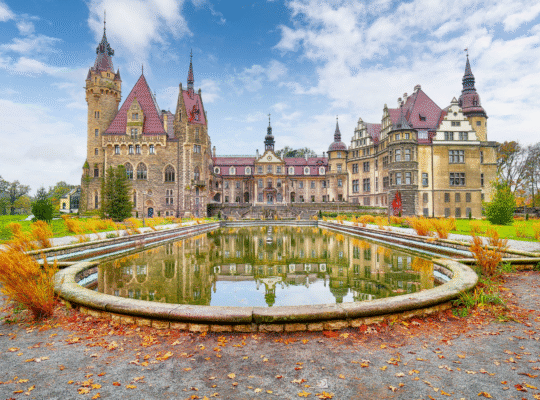If you’ve ever wondered what it’s really like to visit a castle in France, I can tell you this: it’s nothing like the movies, and yet somehow, it’s better. My first castle wasn’t part of a big plan. I was driving through the Loire Valley—following GPS directions that kept trying to reroute me—when I rounded a bend and there it was: Château de Chambord, rising up out of nowhere. I actually laughed out loud in the car. There’s just no way a building should look that dramatic in real life.
That was the moment I realized castles in France aren’t just for fairy tales or history textbooks. They’re real, full of surprises, and very much alive. You don’t need to know all the kings and dates to enjoy them, either. I didn’t. All you need is a bit of curiosity—and maybe a good pair of shoes.
What makes French castles special isn’t just the towers or the old stones. It’s the stories. Some are about queens who built their own bridges, soldiers defending thick walls, or prisoners who left their marks in the dungeons. Others are quieter—families picnicking on the lawns, kids imagining themselves as knights or princesses, couples taking selfies on spiral staircases.
In this guide, I’ll show you ten of the best castles to visit in France. I’ll share practical tips for planning your visit, a few stories you won’t find on the official brochures, and some honest advice about what’s worth your time. If you’re looking for a real experience—not just another tourist stop—these castles should be on your list. Let’s get started.

Quick Reference Table: The 10 Best Castles to Visit in France
| 🏰 Castle | 📍 Location | 🏗️ Era | 🎭 Famous For | 🎲 Fun Fact |
|---|---|---|---|---|
| Château de Chambord | Loire Valley | 16th Century (Renaissance) | Double-helix staircase, grand scale | Leonardo da Vinci may have inspired the design |
| Château de Versailles | Versailles (near Paris) | 17th Century (Baroque) | Hall of Mirrors, royal gardens | The Treaty of Versailles was signed here in 1919 |
| Château de Chenonceau | Loire Valley | 16th Century (Renaissance) | Spans the Cher River, “Ladies’ Castle” | Home to rival queens Catherine de Medici & Diane de Poitiers |
| Château de Carcassonne | Carcassonne, Occitanie | Medieval (12th–14th Century) | Walled city, towers, ramparts | The inspiration for Disney’s Sleeping Beauty castle |
| Château de Fontainebleau | Fontainebleau (SE of Paris) | 12th–19th Century (Renaissance & Classical) | Napoleon’s residence, royal apartments | Napoleon abdicated here in 1814 |
| Château de Pierrefonds | Picardy, Hauts-de-France | 14th & 19th Century (Medieval Revival) | Fairytale looks, TV/film location | Featured in the BBC’s Merlin series |
| Château de Beynac | Dordogne, Nouvelle-Aquitaine | 12th Century (Medieval) | Cliff-top fortress, river views | Once controlled by Richard the Lionheart |
| Château de Haut-Koenigsbourg | Alsace, Grand Est | 12th & 20th Century (Medieval Revival) | Restored fortress, panoramic views | Restored by German Emperor Wilhelm II |
| Mont-Saint-Michel | Normandy | 8th–16th Century (Medieval) | Island abbey-castle, dramatic tides | Entire village becomes an island at high tide |
| Château de Vincennes | Paris | 14th Century (Medieval) | Tallest keep in Europe, moat, history | Famous prisoners included Diderot & Marquis de Sade |

Château de Chambord
Quick Facts
- Location: Loire Valley, near Blois
- Construction Period: 1519–1547
- Architectural Style: French Renaissance
- Famous For: Double-helix staircase, massive scale, blend of medieval and Renaissance styles
- Notable Figures: King Francis I, Leonardo da Vinci (possible influence)
- UNESCO Status: Part of the Loire Valley World Heritage Site
- Official Website: chambord.org
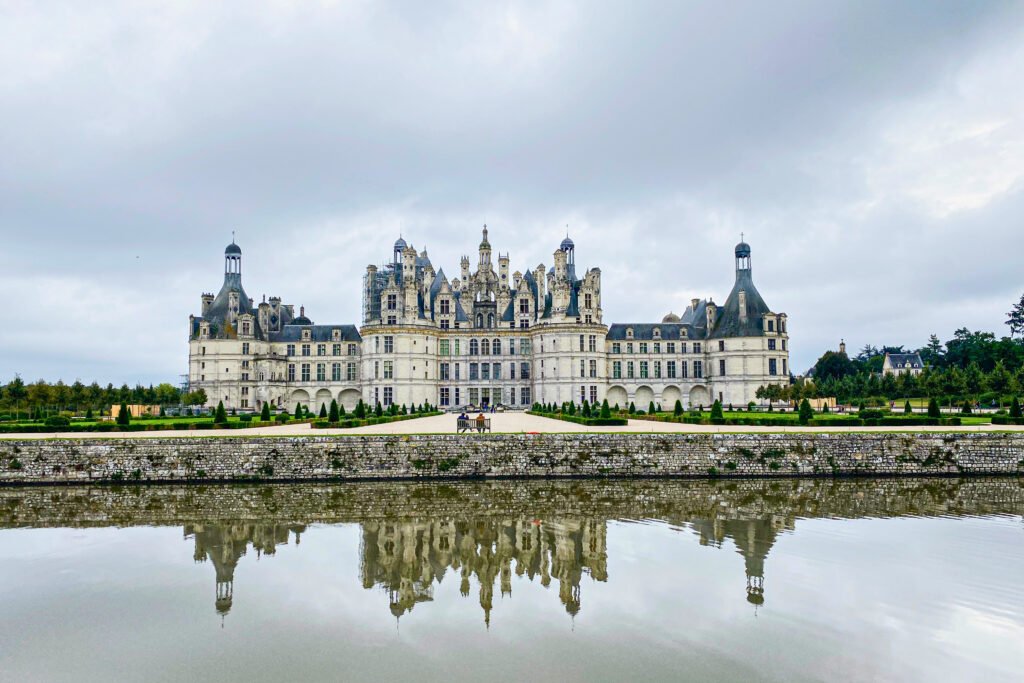
Walk up to Chambord and you’ll probably stop in your tracks. The first thing that hits you isn’t just the size—though it is huge, easily the largest château in the Loire Valley. It’s the wild, over-the-top silhouette: a mass of turrets, chimneys, spires, and towers shooting up in every direction, almost like the designers just kept adding “one more thing.” Chambord feels half-castle, half-palace, and totally unique.
A Brief, Surprising History
King Francis I wanted Chambord as a hunting lodge. That’s right—a “lodge.” He was barely 25 when construction began in 1519, and he wanted something to show off his power and taste. He barely used it, though. The château was so massive and hard to heat that Francis and his royal entourage only stayed a few weeks at a time. Even unfinished, it’s a masterpiece of ambition.
One of the most famous features is the double-helix staircase in the main keep. Legend says Leonardo da Vinci inspired it during his final years in France. Two people can go up and down the twin spirals at the same time and never meet—try it with a friend, and you’ll see how fun (and a little confusing) it is.
Chambord was built for show, not comfort. Later kings visited, but it never became a permanent residence. During the French Revolution, much of the furniture was sold off. It’s survived wars, looting, and long periods of abandonment, but its grandeur has never faded.
Legends and Quirks
Local legend has it that secret passages still exist beneath the château, and some say Francis I hid treasures here. Another story: during World War II, masterpieces from the Louvre—like the Mona Lisa—were hidden at Chambord to keep them safe from the Nazis. Whether or not the ghosts of past kings walk the halls, it’s true that the air in certain corridors feels heavy with secrets.
What Makes Chambord a Must-Visit?
If you want to see the most outrageous castle in France, this is it. Chambord is as close as you’ll get to a real-life castle dream—impressive outside and in. The rooftop terraces give you a close-up look at the forest of chimneys and spires, plus sweeping views over the vast estate. Bring your camera: every angle is different.
It’s also a place where you can actually wander. Climb spiral staircases, peek into royal chambers, and get lost in the maze of corridors. The grounds themselves are huge—think miles of forest, gardens, and even wild deer if you’re lucky.
France Castle Travel Tips: Visiting Chambord
- Getting There: About 2 hours by train or car from Paris (Blois is the nearest major station, with shuttles to Chambord).
- Entry: Adult tickets are usually €16–€19 (gardens included); free for under-18s from the EU.
- Hours: Open year-round; hours vary, so check the official site before you go.
- Tours: Guided tours in English and French available. Don’t skip the rooftop terraces!
- Accessibility: Elevators available for main floors, but many areas require climbing stairs.
- Must-Know: Arrive early or late to avoid crowds. The grounds are open for walking, picnics, or even bike rentals.
👉 There’s so much more to uncover—from hidden passages to royal intrigues. If you’re curious, don’t miss our in-depth guide to Château de Chambord right here.
Nearby Attractions
Make it a day trip by visiting the charming city of Blois (great for lunch and a stroll), or pair Chambord with the equally stunning Château de Cheverny, just a short drive away.
There’s a reason Chambord earned UNESCO World Heritage status. Once you climb up to those rooftop terraces and see the endless spires and forests spread out below, it just makes sense. There’s nothing else like it in France—or anywhere, really.

Château de Versailles
Quick Facts
- Location: Versailles, just outside Paris
- Construction Period: 1661–1710
- Architectural Style: French Baroque
- Famous For: Hall of Mirrors, immense gardens, the seat of the French monarchy
- Notable Figures: Louis XIV (“the Sun King”), Marie Antoinette, Louis XVI
- UNESCO Status: Yes, the Palace and Park of Versailles (designated in 1979)
- Official Website: chateauversailles.fr
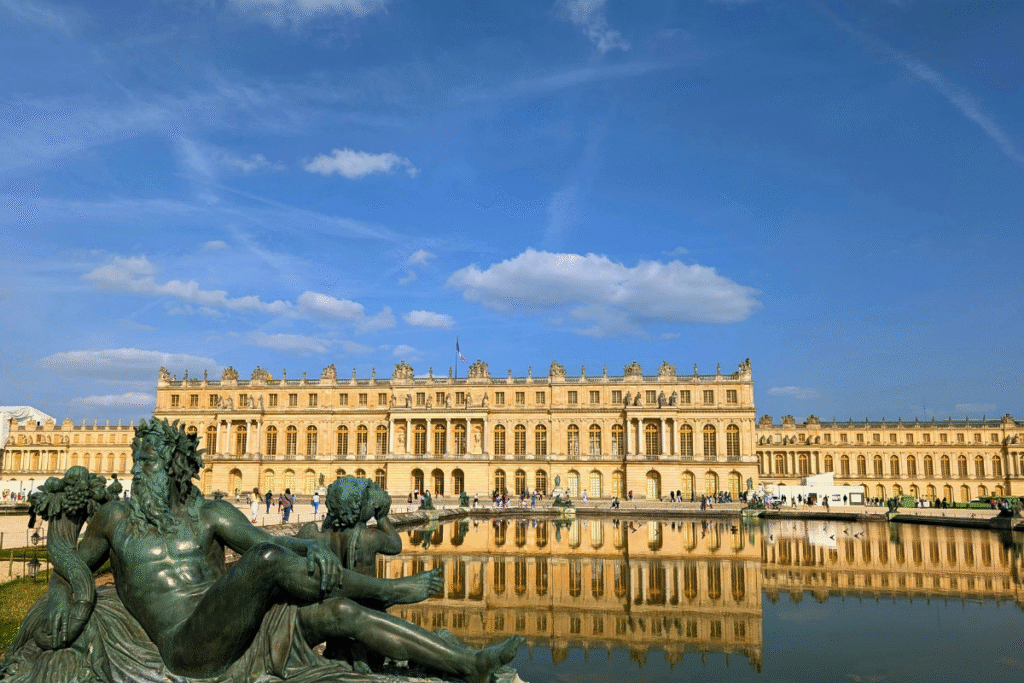
Versailles isn’t just a castle—it’s the castle, the gold standard for royal luxury, excess, and drama. Walking through its gates for the first time, it’s hard not to feel a bit small. Golden gates, vast courtyards, fountains, perfectly trimmed hedges for miles—Versailles is on a scale that’s almost hard to believe, even when you’re standing right in the middle of it. It’s not every day you step into a UNESCO World Heritage site, but the moment you pass through Versailles’ golden gates, you understand why it earned that honor.
The Story Behind the Splendor
Versailles started as a hunting lodge for Louis XIII, but it was his son, Louis XIV, who decided it should be the most magnificent palace in Europe. Construction ramped up in the late 1600s. Louis XIV moved the royal court and government here, turning Versailles into the center of French power and style. For over a century, this was where decisions that shaped the world were made, and where parties were thrown that set the bar for decadence.
The Hall of Mirrors is the showstopper—over 70 meters long, lined with 357 mirrors reflecting sunlight into dazzling rainbows. It’s also where the Treaty of Versailles was signed in 1919, officially ending World War I. So yes, history is very much alive here.
Legends and Royal Drama
Versailles has seen it all—secret love affairs, political plotting, revolutionary whispers, and even escape attempts. Marie Antoinette famously tried (and failed) to flee the revolution, disappearing through the palace’s secret corridors. Some say her spirit still lingers in her private hamlet, just outside the main palace.
There are endless stories of hidden tunnels, masked balls, and extravagant feasts. If you listen to the local guides, you’ll hear tales of secret gardens where only the favored few were allowed to wander. More than a few visitors swear they’ve felt a sudden chill in the palace, as if history itself is brushing past.
Why Versailles Makes the List
You can’t talk about the best castles in France without mentioning Versailles. It’s the most famous, the most opulent, and—thanks to its gardens—the most peaceful and chaotic at once. The place is a masterclass in French art and architecture, and its gardens are just as spectacular as the palace itself. Even if you’re not a history buff, the sheer extravagance is worth experiencing.
And honestly? Versailles is big enough that, if you wander away from the main crowd, you’ll find pockets of quiet that feel almost private—especially in the smaller palaces and the parklands.
France Castle Travel Tips: Visiting Versailles
- Getting There: Easy train ride from Paris (RER C line to Versailles Château Rive Gauche station, then a 10-minute walk).
- Entry: Palace only ticket €21; combo tickets and family passes available. Check the official website for the most up-to-date visiting information.
- Hours: Closed Mondays. Gardens open daily. Arrive early or late to dodge crowds.
- Tours: Guided tours available (book ahead for English). The “King’s Private Apartments” tour is worth the splurge.
- Accessibility: Most main areas are wheelchair accessible. Gardens have some gravel paths.
- Must-Know: Mondays are for gardens only (palace closed). The musical fountain shows are a treat if you’re visiting in spring or summer.
👉 For a complete look at what to see, when to go, and how to make the most of your visit, check out our in-depth Palace of Versailles travel guide here.
Nearby Attractions
- Marie Antoinette’s Hamlet: A quirky little village built for the queen, hidden within the palace grounds.
- The City of Versailles: Charming streets, great markets, and plenty of places to grab a pastry or coffee.
- Trianon Palaces: Smaller, more intimate royal retreats within walking distance.
Versailles isn’t just for history fans or architecture lovers—it’s for anyone who wants to see how far human imagination and ambition can go. Come ready to be impressed, and maybe bring an extra memory card for your camera.

Château de Chenonceau
Quick Facts
- Location: Loire Valley, near Tours
- Construction Period: 1513–1521 (main structure)
- Architectural Style: French Renaissance
- Famous For: Its graceful arches spanning the River Cher; “The Ladies’ Castle”
- Notable Figures: Diane de Poitiers, Catherine de Medici, Louise Dupin
- UNESCO Status: Part of the Loire Valley World Heritage Site
- Official Website: chenonceau.com

Approaching Chenonceau feels a bit like entering a dream. As part of the UNESCO World Heritage-listed Loire Valley, this château isn’t just beautiful—it’s globally recognized for its elegance and history. With graceful white stone, slate rooftops, and a gallery that stretches right over the River Cher, Chenonceau stands apart. It’s the only major castle in France built directly over a river, and when the sun hits those arches just right, the reflection alone is worth the trip.
A Castle Built (and Battled Over) by Women
Chenonceau isn’t just beautiful—it’s famous for its backstory. For centuries, women have shaped its fate. The original château was built by Katherine Briçonnet, but the real drama came later. Diane de Poitiers, mistress of King Henry II, received it as a gift, added the beautiful arched bridge, and turned it into a Renaissance jewel. But after Henry’s death, his formidable widow Catherine de Medici forced Diane out and took over herself. Catherine extended the bridge, creating the two-story gallery that makes Chenonceau instantly recognizable.
During World War I, the gallery was converted into a hospital ward. In World War II, the château became a lifeline—the Cher River formed the border between Nazi-occupied France and the free zone, so the castle’s long gallery was literally an escape route for people fleeing danger.
Legends, Secrets, and Quiet Power
With a nickname like “The Ladies’ Castle,” there are plenty of stories. Some say Catherine de Medici’s ghost still strolls the gardens, while others talk about the secret messages sent through the castle’s winding passages during wartime. Guides love to tell the story of Louise Dupin, who protected Chenonceau from destruction during the French Revolution simply by charm, negotiation, and sheer stubbornness.
Even if you’re not into legends, just walking the flower-filled paths or standing in the long, sunlit gallery gives you a sense of the lives—and drama—that played out here.
What Makes Chenonceau Special?
Chenonceau stands out because it feels personal. It’s smaller and more intimate than the giants like Chambord or Versailles, and it’s packed with personality. The rooms are full of fresh flowers (still arranged daily), and the kitchen, nestled right on the riverbank, feels like a place where real people actually lived. If you’re looking for beauty, romance, and a sense of real history, this castle delivers.
The gardens are gorgeous, too—there’s one designed by Diane and another by Catherine, each reflecting the tastes and rivalry of their creators.
France Castle Travel Tips: Visiting Chenonceau
- Getting There: Train from Paris to Tours or Chenonceaux station; a short walk from the local station.
- Entry: Adult ticket €18; includes access to gardens, galleries, and kitchens.
- Hours: Open every day, year-round. Check the official website for seasonal hours.
- Tours: Free audio guides; guided tours in English and French available.
- Accessibility: Most of the château and gardens are accessible, though some upper rooms require stairs.
- Must-Know: Arrive early for the quietest experience, or late afternoon for beautiful light over the river.
Nearby Attractions
- Château d’Amboise: Home of Leonardo da Vinci, a short drive away.
- Wine Tasting: The Loire Valley is known for crisp whites and rosés—local wineries are everywhere.
- Biking: The castle is along the Loire à Vélo route, perfect if you want to explore the countryside on two wheels.
If you want a castle that combines storybook charm with real stories of resilience and rivalry, Chenonceau is a must. It’s the kind of place where you don’t just see history—you can almost feel it.

Château de Carcassonne
Quick Facts
- Location: Carcassonne, Occitanie (southern France)
- Construction Period: 12th–14th centuries (with Roman origins dating to the 3rd century)
- Architectural Style: Medieval fortified city
- Famous For: Imposing double walls, 52 towers, and the feel of a real-life fairytale fortress
- Notable Figures: Simon de Montfort, the Trencavel family
- UNESCO Status: Yes, part of Historic Fortified City of Carcassonne (designated in 1997)
- Official Website: remparts-carcassonne.fr
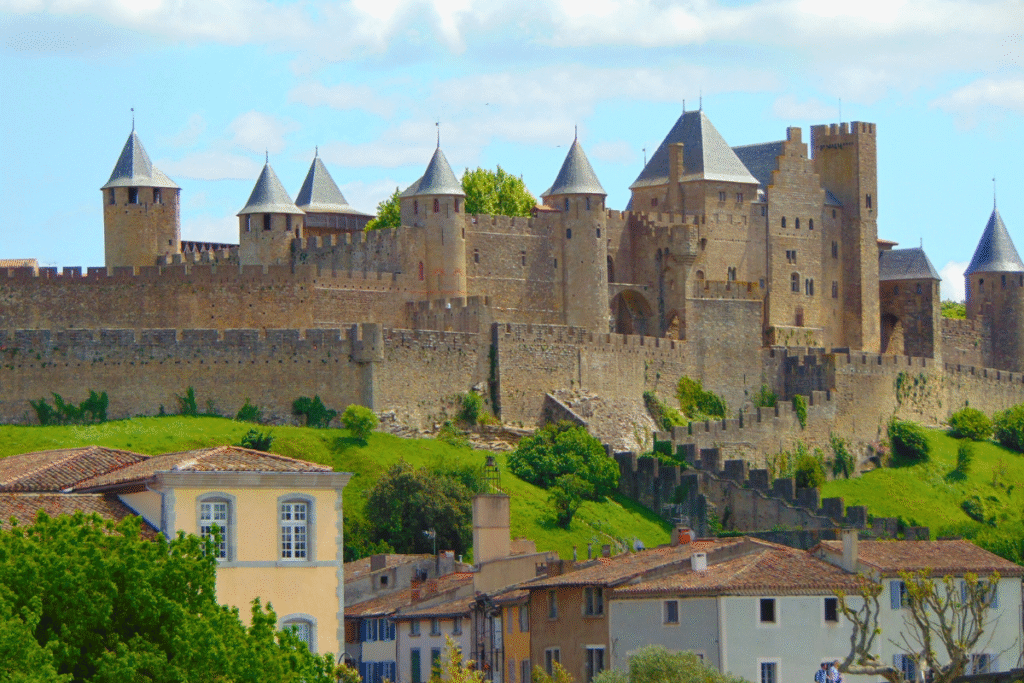
If you’ve ever built a sandcastle and dreamed of it coming to life, Carcassonne is the real thing—and UNESCO agrees. This walled city, a designated World Heritage site, is famous for its massive stone walls and row upon row of towers. The first time you see it, it’s hard to believe people built this by hand. Walking through the main gate is like stepping onto a medieval movie set—except here, everything you see is the real deal.
A Fortress With Layers of History
The story of Carcassonne goes way back—like, Roman Empire back. You can still spot sections of old Roman wall, but the real castle you see today took shape during the Middle Ages, when Carcassonne was a critical stronghold in the battles between the French crown and local lords. During the 13th century, Simon de Montfort stormed the city during the Albigensian Crusade, changing the region’s fate forever.
By the 1800s, Carcassonne was falling apart. The French government almost demolished it, but architect Eugène Viollet-le-Duc (a hero among castle lovers) led a massive restoration. His work saved Carcassonne, though some purists grumble about the pointy “witch’s hat” roofs he added to the towers. Today, the fortress is a UNESCO site and one of the best-preserved medieval cities in Europe.
Legends, Myths, and Medieval Mischief
The name “Carcassonne” itself is tied to a legend: During a siege, the city’s clever lady, Dame Carcas, tricked the enemy army by throwing a stuffed pig over the walls, making them believe the city had plenty of food. The invaders left, and Dame Carcas “rung the bells” (“Carcas sonne”) to celebrate. True or not, it’s a story you’ll hear everywhere in town.
There are also whispers of secret passages and haunted towers—especially at dusk, when the crowds thin and the shadows stretch.
Why Carcassonne Belongs on Your List
Unlike many castles, Carcassonne is an entire walled city. Inside, you’ll find cobbled lanes, tiny shops, restaurants, hotels, and homes—people really live here. You can walk the ramparts, climb towers, and imagine what it was like to defend a fortress with boiling oil and crossbows. For kids (and adults with a sense of adventure), it’s about as close as you’ll get to living out a knight’s dream.
It’s also a photographer’s dream. Sunrise and sunset light up the golden stone, and the views from the walls stretch for miles over the Aude River valley.
France Castle Travel Tips: Visiting Carcassonne
- Getting There: Direct trains from Toulouse; local buses serve the town from the train station.
- Entry: The old city is free to wander; entry to the Château Comtal and ramparts is around €13-€19. Check the official website for the most up-to-date visiting information.
- Hours: Open daily, but hours vary by season. Summer is busiest—arrive early or late for fewer crowds.
- Tours: Guided tours in several languages; audio guides available.
- Accessibility: The cobblestones and stairs make parts tricky for wheelchairs, but much of the old city is accessible.
- Must-Know: Stay after dark—the illuminated walls are stunning, and the city feels entirely different at night.
Nearby Attractions
- Canal du Midi: UNESCO-listed canal perfect for boat rides and cycling.
- Basilica of Saints Nazarius and Celsus: Beautiful Gothic church within the walls.
- Local Food: Try cassoulet, a hearty local stew, at one of the city’s cozy restaurants.
If you’ve ever wanted to step into a real medieval world, Carcassonne should be at the top of your French castle travel list. It’s a full-on immersion in history, myth, and pure adventure.

Château de Fontainebleau
Quick Facts
- Location: Fontainebleau, 55 km southeast of Paris
- Construction Period: 12th–19th centuries (major expansions during the Renaissance)
- Architectural Style: Renaissance and Classical
- Famous For: Royal apartments, Renaissance art, Napoleon’s favorite residence
- Notable Figures: Francis I, Napoleon Bonaparte, Marie Antoinette
- UNESCO Status: Yes, designated in 1981
- Official Website: chateaudefontainebleau.fr
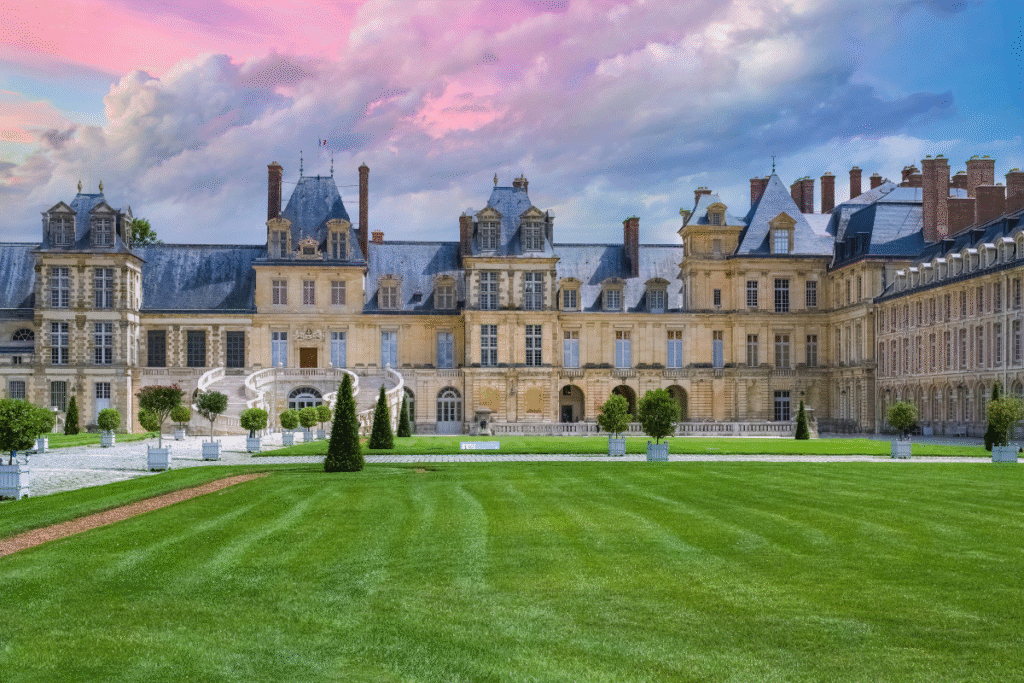
If you want to see where the real power players of French history spent their days—and nights—Fontainebleau is the place. Recognized as a UNESCO World Heritage site, Fontainebleau isn’t just a royal residence; it’s a living record of centuries of French culture. Unlike the formal, almost intimidating grandeur of Versailles, Fontainebleau feels like a lived-in royal home (albeit on a royal scale). As you wander through halls filled with Renaissance masterpieces and antique furniture, you get the sense that, behind every ornate door, someone important might just stroll through.
A Royal Playground for Centuries
Fontainebleau’s story starts in the Middle Ages, but it really comes to life in the Renaissance. King Francis I rebuilt it into a palace to rival Italy’s finest, importing artists and craftsmen from Florence and Rome. It became the blueprint for French Renaissance style, and every French monarch from Francis I to Napoleon left their mark here. That’s over 800 years of royal history, all under one roof.
Napoleon adored Fontainebleau, calling it “the true home of kings.” He signed his first abdication here in 1814, delivering a farewell speech to his loyal guards before heading into exile. Many of the rooms remain just as he left them, right down to his campaign bed and imperial eagle banners.
Legends, Ghosts, and Hidden Passages
Fontainebleau has more than its fair share of legends. The most famous is the Red Man of the Forest—a mysterious figure in red who was said to appear before disaster struck the royal family. Some say he still haunts the gardens. Other stories tell of hidden doors, secret meeting rooms, and affairs of the heart (and state) played out in shadowy corridors.
It’s a place where history feels close: you can stand on the horseshoe staircase where Napoleon made his dramatic farewell, or look out over the carp-filled Grand Canal and imagine royal picnics and hunting parties.
Why Fontainebleau Is a Must-Visit
Fontainebleau stands out because it combines grandeur with genuine warmth. There’s an easy-going vibe in the gardens, and the surrounding forest is a favorite for walkers, climbers, and even horseback riders. Art lovers will be blown away by the intricate frescoes and galleries; military history buffs will geek out over Napoleon’s apartments. And if you like a place that’s a little less crowded than Versailles, you’ll love it here.
France Castle Travel Tips: Visiting Fontainebleau
- Getting There: Take a train from Paris Gare de Lyon to Fontainebleau-Avon (about 40 minutes), then a local bus or walk (about 30 minutes).
- Entry: Adult ticket €14; free for EU residents under 26. Park and gardens are free to access. Check the official website for the most up-to-date visiting information.
- Hours: Closed Tuesdays; check the official site for seasonal hours.
- Tours: Audio guides in multiple languages; guided tours available (especially good for Napoleon’s quarters).
- Accessibility: Most main areas are accessible, though there are some stairs in historic wings.
- Must-Know: Don’t skip the gardens—they’re quieter than Versailles and just as beautiful.
Nearby Attractions
- Fontainebleau Forest: Popular for hiking, rock climbing, and picnicking.
- Town of Fontainebleau: Charming cafes, bakeries, and shops just outside the castle gates.
- Barbizon Village: Picturesque artists’ village on the edge of the forest, famous for 19th-century painters.
Fontainebleau isn’t just a slice of French royal history—it’s a palace where you can genuinely relax and soak in the past without the crowds. It’s perfect for anyone who wants a real, approachable taste of France’s regal heritage.

Château de Pierrefonds
Quick Facts
- Location: Pierrefonds, Hauts-de-France (about 85 km northeast of Paris)
- Construction Period: Originally 14th century; rebuilt in the 19th century
- Architectural Style: Medieval Revival (Neo-Gothic)
- Famous For: Fairytale looks, dramatic towers, TV and film location
- Notable Figures: Louis of Orleans, Napoleon III, architect Viollet-le-Duc
- UNESCO Status: Not listed
- Official Website: pierrefonds.monuments-nationaux.fr

Some castles look serious, some look elegant, but Pierrefonds? This one looks like it just stepped out of a storybook. With its soaring turrets, pointy rooftops, wide moat, and massive drawbridge, it’s the definition of a “wow” moment. Kids will lose their minds, photographers will run out of memory cards, and even adults have a hard time not feeling like a character in a fantasy film.
From Ruins to Movie Stardom
Originally built for Louis of Orleans in the late 1300s, Pierrefonds had a rough run: besieged, ruined, and basically abandoned by the 17th century. For nearly 200 years, it was just a romantic ruin—artists loved to paint its crumbling towers.
Enter Napoleon III, who wanted a castle worthy of France’s medieval heritage. He hired the famous architect Viollet-le-Duc (who also saved Carcassonne) to restore Pierrefonds—not just to its former glory, but into a perfect medieval fantasy. The result? A castle so epic that it’s been used in countless movies and TV shows, including the BBC’s “Merlin.”
Legends, Mystery, and a Touch of the Gothic
Pierrefonds’ looks are legendary, but so are its stories. Locals talk of ghostly knights haunting the towers, and more than one visitor has claimed to see flickering lights in empty halls at night. Guides will point out the “Hall of the Dead,” lined with eerie sculptures of mourning figures—a favorite with anyone who enjoys a touch of the macabre.
There’s also the story of secret tunnels running beneath the castle, used for escape (or mischief) during times of siege. Even if you don’t buy into the ghost stories, Pierrefonds is undeniably atmospheric—especially on a foggy morning.
Why Visit Pierrefonds?
This is one of the best castles in France if you want pure drama. Pierrefonds is less crowded than the big-name Loire châteaux and perfect for families, fantasy fans, or anyone who wants to see what a “real” castle should look like. You can climb towers, explore dark passages, and take in spectacular views over the surrounding forest.
It’s also refreshingly hands-on: there are exhibits about castle life, armor displays, and even costumed medieval festivals in summer.
France Castle Travel Tips: Visiting Pierrefonds
- Getting There: Drive from Paris (about 1.5 hours); nearest train station is Compiègne, then a local bus or taxi.
- Entry: Adult ticket €9; discounts for under 26, students, and families. Check the official website for the most up-to-date visiting information.
- Hours: Open daily, with longer hours April–September. Closed some holidays.
- Tours: Self-guided is easy; guided tours are available in French.
- Accessibility: Main rooms and grounds are accessible; towers require stairs.
- Must-Know: Bring a picnic or eat in the village—Pierrefonds itself is small but charming.
Nearby Attractions
- Compiègne Forest: Gorgeous for hiking, especially in spring and autumn.
- Compiègne Palace: Another royal residence with beautiful gardens, just a short drive away.
- Lake Pierrefonds: Right next to the castle, perfect for a lakeside stroll or pedal boating.
If you want a castle that brings every childhood fantasy to life—and gives you an epic photo for your trip—Pierrefonds is an absolute must. You’ll walk away grinning, no matter your age.

Château de Beynac
Quick Facts
- Location: Beynac-et-Cazenac, Dordogne, Nouvelle-Aquitaine
- Construction Period: 12th century, expanded over time
- Architectural Style: Medieval fortress
- Famous For: Clifftop views over the Dordogne River, preserved medieval interiors
- Notable Figures: Richard the Lionheart, Simon de Montfort, the Beynac family
- UNESCO Status: Not listed (but part of the wider Dordogne Valley, a candidate for UNESCO status)
- Official Website: chateau-beynac.com
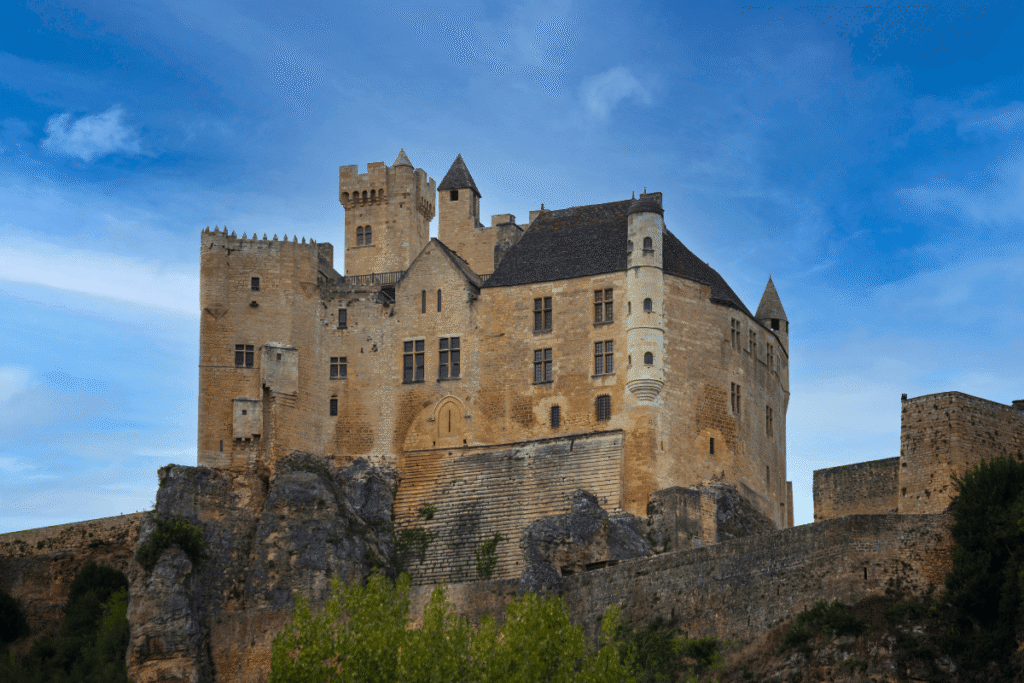
If you’re looking for a real medieval stronghold—the kind of place that looks straight out of a movie—Beynac is hard to beat. This is one of those castles that doesn’t just stand on a hill; it dominates the landscape, perched 150 meters above the Dordogne River on a sheer limestone cliff. When you see it from below, you can instantly understand why armies thought twice about attacking it.
Centuries of Battles and Feuds
Beynac’s story is classic medieval France: rival families, sieges, and shifting alliances. Built in the 1100s by the powerful Beynac family, the castle quickly became a key fortress during the Hundred Years’ War. The French held Beynac, while the English were often holed up in Castelnaud—the next castle over, visible from Beynac’s ramparts. Imagine neighbors feuding, but with armies instead of hedge clippers.
Richard the Lionheart even stayed here, and the castle’s thick walls and arrow slits tell you everything about its defensive purpose. Over the centuries, Beynac was modernized and expanded, but it’s still the best place in the Dordogne to feel the reality of medieval warfare.
Legends and Medieval Mystique
Locals say the castle is haunted by the restless spirits of soldiers who died during the many sieges. One tale claims that secret passages run under the rock, used by defenders to escape or launch sneak attacks. The old dungeon and the echoing chapel add just the right amount of spooky atmosphere—especially if you visit late in the day.
Beynac was also a filming location for movies like “The Messenger: The Story of Joan of Arc” and “Chocolat.” It’s the kind of place that makes you believe in legends.
Why Beynac Is Unmissable
What makes Beynac stand out? The view, for starters. Climb to the top and you’ll get a sweeping panorama of the Dordogne valley—rolling hills, river bends, and other castles dotting the landscape. Inside, the rooms are stark and simple, just as they were in the Middle Ages. You’ll find a real sense of authenticity here: thick stone walls, winding staircases, and rooms filled with medieval artifacts.
It’s also quieter than many of France’s big-name castles. You can actually take your time, let your imagination wander, and enjoy the sense of stepping into another era.
France Castle Travel Tips: Visiting Beynac
- Getting There: Easiest by car; limited public transport. The climb from the village to the castle is steep—wear good shoes!
- Entry: Adult ticket €11.50; discounts for children and families. Check the official website for the most up-to-date visiting information.
- Hours: Open daily, with longer hours in summer. Last entry usually one hour before closing.
- Tours: Self-guided visits with detailed information boards; guided tours in French during peak times.
- Accessibility: Not suitable for wheelchairs; lots of stairs and uneven paths.
- Must-Know: The village of Beynac-et-Cazenac is gorgeous—leave time to explore its narrow lanes and riverside cafes.
Nearby Attractions
- Castelnaud-la-Chapelle: Another iconic castle just across the river—great for a “castle day.”
- La Roque-Gageac: Stunning riverside village nearby.
- Canoeing on the Dordogne: Paddle beneath Beynac for a unique view of the fortress.
For anyone who dreams of medieval adventure, Beynac is the real deal. Visit for the history, stay for the view, and leave with a camera full of epic photos.

Château du Haut-Koenigsbourg
Quick Facts
- Location: Orschwiller, Alsace (northeastern France)
- Construction Period: Original 12th century; major 20th-century restoration
- Architectural Style: Medieval (with Neo-Gothic restoration elements)
- Famous For: Panoramic views over Alsace, impressive restoration, fortress features
- Notable Figures: Wilhelm II (German Emperor), Hohenstaufen dynasty
- UNESCO Status: Not listed
- Official Website: haut-koenigsbourg.fr
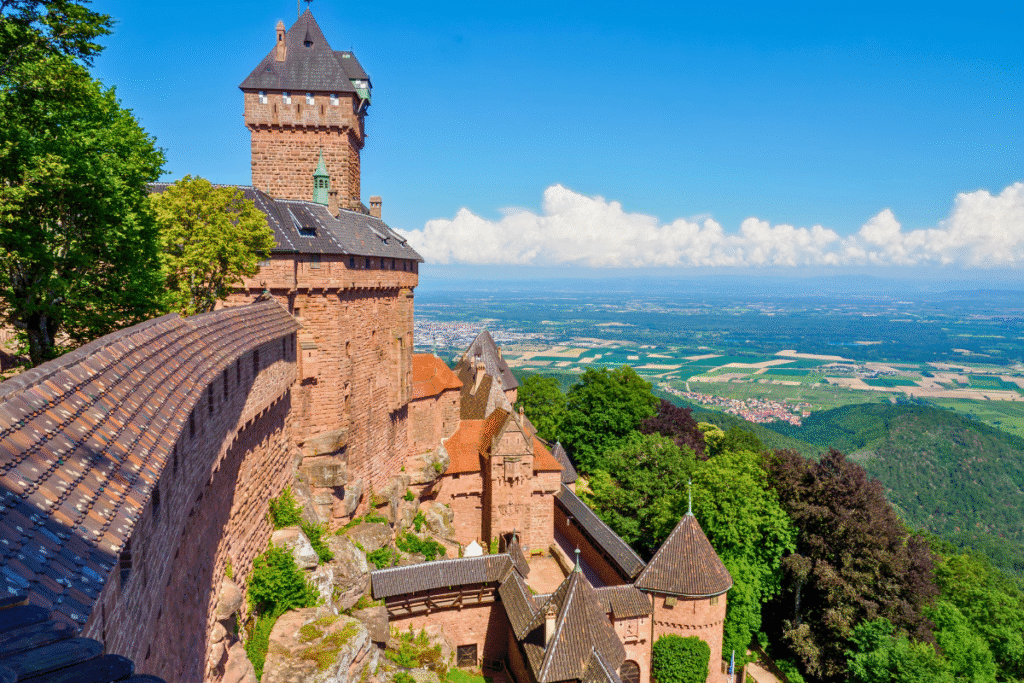
Driving through the vineyards and villages of Alsace, Haut-Koenigsbourg pops up on the horizon like something from a legend—high on its rocky perch, red sandstone walls glowing in the afternoon sun. Even before you step inside, you can see why emperors and kings wanted to control this spot: from the ramparts, you can see across the Rhine to Germany and, on a clear day, all the way to the Black Forest.
A Fortress Built to Impress (and Intimidate)
First built in the 1100s by the Hohenstaufen family, Haut-Koenigsbourg spent centuries as a coveted stronghold, passed back and forth between rival lords, kings, and emperors. It was besieged, burned, rebuilt, and eventually abandoned after the Thirty Years’ War. For over two centuries, it was left in ruins—a haunting symbol of lost power.
Then, in the early 1900s, the German Emperor Wilhelm II ordered a dramatic restoration. He wanted a showcase of medieval grandeur, so architect Bodo Ebhardt rebuilt the castle to match its imagined glory days, complete with drawbridges, weapon rooms, and hunting halls. Some historians grumble about historical accuracy, but the result is undeniably spectacular—and incredibly fun to explore.
Legends and Local Lore
Like any good castle, Haut-Koenigsbourg comes with its share of legends. Locals tell stories of secret tunnels running deep into the mountain, and some say the fortress is still watched over by the ghosts of long-ago defenders. One popular myth is that the castle is enchanted to protect Alsace in times of trouble—a romantic notion in a region that has seen more than its fair share of wars.
There are also tales of hidden treasures, never found despite centuries of searching—so keep your eyes open as you wander the armories and great halls.
Why Visit Haut-Koenigsbourg?
This is the castle to visit if you love dramatic views and immersive atmosphere. Inside, you’ll find reconstructed kitchens, a grand banqueting hall, an armory loaded with medieval weapons, and winding staircases that lead up to the highest watchtowers. Unlike many French castles, Haut-Koenigsbourg really feels like a fortress—solid, imposing, and ready for battle.
It’s also a favorite with families and photographers: the ramparts, towers, and the huge inner courtyard are endlessly photogenic. And because it’s perched so high, you’ll get some of the best panoramic views in France.
France Castle Travel Tips: Visiting Haut-Koenigsbourg
- Getting There: Best by car; shuttle buses run from Sélestat train station during peak season.
- Entry: Adult ticket €12; discounts for children, families, and groups. Check the official website for the most up-to-date visiting information.
- Hours: Open daily, except January 1, May 1, and December 25; longer hours April–September.
- Tours: Free self-guided visit; guided tours (French, German, English) at set times.
- Accessibility: Steep paths and many stairs; not suitable for wheelchairs.
- Must-Know: Bring layers—the wind can be strong, even in summer. Arrive early for the quietest experience.
Nearby Attractions
- Alsace Wine Route: Picturesque villages and excellent vineyards all around.
- Montagne des Singes: Monkey sanctuary nearby, great for families.
- Eagle Park (La Volerie des Aigles): Live bird of prey demonstrations in a nearby ruined castle.
Haut-Koenigsbourg is the castle for anyone who loves a bit of drama—both historical and natural. Come for the views, stay for the stories, and enjoy one of France’s best-kept castle secrets.

Mont-Saint-Michel
Quick Facts
- Location: Normandy, on the border with Brittany
- Construction Period: 8th–16th centuries
- Architectural Style: Romanesque and Gothic
- Famous For: Dramatic island setting, abbey perched atop the mount, tidal extremes
- Notable Figures: Saint Aubert (founder), the Benedictine monks
- UNESCO Status: Yes (Since 1979 as Mont-Saint-Michel and its Bay)
- Official Website: montsaintmichel.fr
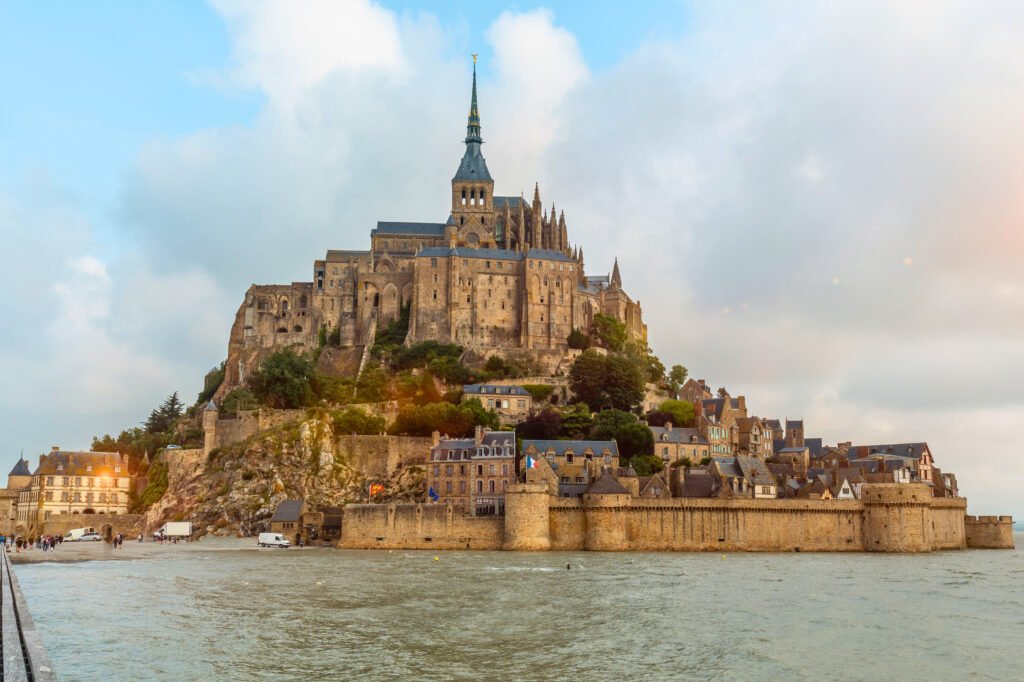
Even if you’ve never set foot in France, chances are you’ve seen a photo of Mont-Saint-Michel. Named a UNESCO World Heritage site, this island abbey is one of the most iconic sights in the world—a rocky outcrop topped by a storybook monastery, surrounded by swirling tides that sweep in and out faster than you’d ever expect. No matter how many times you see it, arriving in person is unforgettable.
Where Faith and Fortress Meet
The first monastery was built here in 708, after a local bishop (Saint Aubert) supposedly saw the Archangel Michael in a dream. Over the centuries, the abbey grew taller and more elaborate, rising above the village that hugs the lower slopes. For much of the Middle Ages, Mont-Saint-Michel was both a spiritual center and a formidable fortress, withstanding repeated English sieges during the Hundred Years’ War.
For nearly a thousand years, monks lived, prayed, and worked atop the mount. During the French Revolution, the abbey was turned into a prison. Today, it’s open to all—a working religious site and a bucket-list destination for travelers.
Legends, Miracles, and Mysteries
Mont-Saint-Michel has no shortage of legends. Some say Saint Aubert’s skull still bears the hole where Michael touched him, proof of the archangel’s visit. There are tales of pilgrims crossing the treacherous sands at low tide, sometimes guided by mysterious lights. The island’s rapid tides—among the fastest in Europe—are legendary in their own right, turning Mont-Saint-Michel into a true island twice a day.
Local guides love to point out the spot where the Archangel Michael is said to have appeared. Even if you’re not superstitious, the mount’s atmosphere feels thick with centuries of hopes, fears, and prayers.
Why Mont-Saint-Michel Belongs on Your List
There’s really nowhere else like it. The mix of religious history, natural spectacle, and medieval architecture is unbeatable. Climb the winding lanes to the abbey at the summit, and you’ll pass ancient shops, narrow passageways, and viewpoints where the bay stretches to the horizon.
The abbey itself is the highlight—gothic arches, peaceful cloisters, and views you’ll never forget. It gets busy, but somehow always feels magical. Stay late or arrive early and you might even have a quiet corner all to yourself.
France Castle Travel Tips: Visiting Mont-Saint-Michel
- Getting There: Train to Pontorson, then a shuttle; parking lots on the mainland with free shuttle buses across the causeway.
- Entry: The village is free; abbey entrance €13-€16, with free entry for under 26s (EU residents). Check the Abbey's official website for the most up-to-date visiting information.
- Hours: Abbey open daily, closed January 1, May 1, and December 25.
- Tours: Audio guides in multiple languages; guided tours (included in ticket) at set times.
- Accessibility: Lots of steep, narrow steps—wear good shoes and pack light.
- Must-Know: Check the tide times—high tide completely surrounds the mount. Try to visit at sunrise or sunset for the best light (and smaller crowds).
👉 Want to know more about the Mont-Saint-Michel? Don’t miss our in-depth Mont-Saint-Michel guide right here.
Nearby Attractions
- Bayeux: See the famous tapestry and explore this historic town.
- Saint-Malo: Walled port city with pirate history, a short drive away.
- Normandy Beaches: D-Day sites within a couple hours’ drive.
Mont-Saint-Michel is the definition of iconic—part fortress, part sanctuary, and one hundred percent unforgettable. Visit for the views, the stories, and the feeling of stepping into another world.

Château de Vincennes
Quick Facts
- Location: Eastern edge of Paris, Bois de Vincennes
- Construction Period: 14th–17th centuries
- Architectural Style: Medieval fortress, later Renaissance additions
- Famous For: Tallest medieval keep in Europe, deep moat, royal prison
- Notable Figures: Charles V, Diderot, Marquis de Sade
- UNESCO Status: Not listed
- Official Website: chateau-de-vincennes.fr

For a taste of true medieval Paris, Vincennes delivers. Just a short metro ride from the city center, this castle isn’t all fairy-tale looks or gilded mirrors—instead, it’s a real fortress, complete with a massive stone keep, heavy wooden doors, and one of the deepest moats you’ll find in France. If you’re craving the “knights and dungeons” side of French history, Vincennes is your place.
From Royal Residence to Fortress Prison
Built over several centuries, Vincennes started as a hunting lodge for Louis VII and eventually grew into a serious royal palace under Charles V in the 1300s. Its centerpiece is the soaring donjon, or keep, which still holds the record for tallest in Europe at 52 meters (that’s over 170 feet). Royalty once lived here, but as Paris grew in power, Vincennes’ role shifted—from a king’s home to a state prison.
Big names spent time behind its walls, including Enlightenment philosopher Denis Diderot and infamous libertine the Marquis de Sade. During World War II, the Nazis used the castle for executions. Walk through its echoing halls and you can almost feel the layers of tense history.
Legends, Escape Plots, and Famous Prisoners
Prison stories at Vincennes are legendary. The Marquis de Sade is said to have carved graffiti into his cell. Diderot supposedly came up with ideas for the first encyclopedia while imprisoned here. There are also tales of daring escape attempts through secret tunnels, though few succeeded—the walls are just that thick.
Local guides like to point out the “haunted” corner of the keep, where lights supposedly flicker at night, and more than one guard has claimed to hear strange footsteps.
Why Vincennes Is Worth a Visit
Vincennes makes this list because it feels authentic. Unlike Versailles’ glitter or Chambord’s Renaissance flair, here you get medieval strength and utility—thick ramparts, arrow slits, and a real sense of what it took to defend a royal home. The keep’s climb is rewarding, with panoramic views over Paris and the surrounding park.
It’s also one of the easiest castles to visit if you’re staying in the capital—no long train or car trip required.
France Castle Travel Tips: Visiting Vincennes
- Getting There: Paris Metro Line 1 to Château de Vincennes; a 2-minute walk from the station.
- Entry: Adult ticket €13; free for under 26s (EU residents). Check the official website for the most up-to-date visiting information.
- Hours: Open daily except January 1, May 1, and December 25; shorter hours in winter.
- Tours: Self-guided or guided tours in French and English. Special themed tours (medieval life, prisoners) are offered throughout the year.
- Accessibility: Keep has many stairs; some ground-level areas and the chapel are accessible.
- Must-Know: The surrounding Bois de Vincennes is Paris’s largest park—plan a picnic or rent a rowboat on the nearby lake.
Nearby Attractions
- Bois de Vincennes: Walking, cycling, gardens, and even a small zoo.
- Parc Floral: Large botanical garden within the park, especially beautiful in spring.
- Paris City Center: Only 20 minutes away by metro—combine Vincennes with other Paris landmarks for an easy day out.
Château de Vincennes is where you go to touch real medieval walls and hear the echoes of centuries. It’s the perfect balance of accessible and awe-inspiring, right on the edge of the city.

Which Castle Is Best for You? Planning Your French Castle Adventure
After reading about these ten legendary châteaux, you might be wondering—how do you choose? France’s castles aren’t just varied in their architecture and history; each one has its own personality, and there’s something here for every kind of traveler. Here’s how to find your perfect match (or matches):
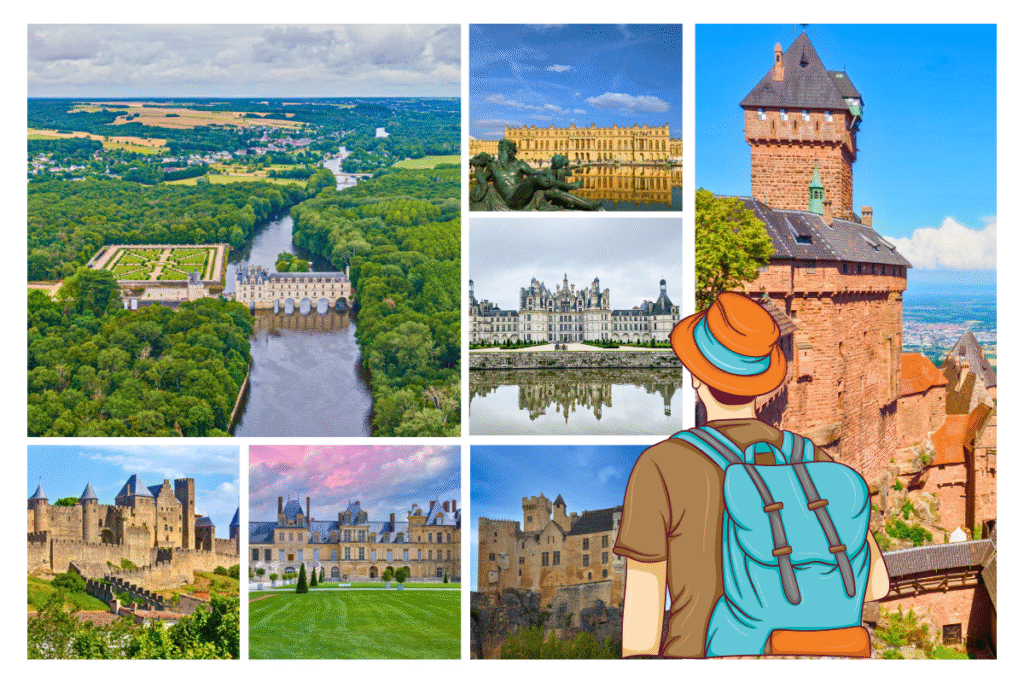
Best Castles for Families
- Carcassonne is unbeatable for families with kids who love adventure. The walled city, towers, and ramparts are like a giant playground where history comes to life.
- Pierrefonds is pure fairytale and just quirky enough to thrill kids and adults alike—think knights, dragons, and fantasy settings.
Most Romantic Castles
- Chenonceau is the ultimate for couples. Between the river, flower gardens, and candlelit galleries, it’s ideal for hand-in-hand walks and quiet moments.
- Versailles (especially the gardens and Marie Antoinette’s Hamlet) is tailor-made for romance, with plenty of hidden corners for a private picnic.
Dream Destinations for History Buffs
- Fontainebleau covers centuries of French royal drama, from the Renaissance to Napoleon.
- Vincennes is your go-to for serious medieval fortification and revolutionary intrigue.
- Carcassonne immerses you in real medieval siege history and restoration debates.
Best for Photographers and Instagram Lovers
- Chambord wins for sheer drama—every angle offers a new, jaw-dropping shot.
- Mont-Saint-Michel is one of the most photographed places on earth, especially at sunrise or sunset when the tides are high.
- Haut-Koenigsbourg offers unbeatable panoramic views and rugged, fortress-like vibes.
Off-the-Beaten-Path and Hidden Gems
- Beynac is less crowded than many Loire castles and offers the Dordogne at its most authentic.
- Haut-Koenigsbourg isn’t as internationally famous, but it’s beloved by those who make the trip for the views and fortress experience.
Suggested Itineraries and Routes
1–2 Day Paris Region:
Start in Paris with a morning at Château de Vincennes (easy Metro ride), then take a quick train or drive out to Fontainebleau for the afternoon. Add Versailles for a full three-castle blitz.
The Loire Valley Loop (2–4 Days):
Base yourself in Tours or Blois and visit Chambord, Chenonceau, and, if you have time, pop over to Amboise or Cheverny. These castles are close enough to bike between for the adventurous.
Dordogne and Southwest France (2–3 Days):
Explore Beynac and Castelnaud in one day, then spend the next at Carcassonne—a train or scenic drive away.
Alsace and the East (1–2 Days):
Spend a day at Haut-Koenigsbourg, then wander through Alsace’s wine villages, stopping at nearby ruins and local vineyards.
Mont-Saint-Michel Detour (1 Day):
Best as a side trip from Normandy or Brittany. Arrive early or stay overnight for a magical, crowd-free experience.
No matter your travel style—solo explorer, family on the move, romantic getaway, or history lover—France’s castles have something special waiting for you. Mix and match to suit your interests, or set yourself a challenge and see how many you can fit into one trip. Just don’t forget to leave a little time for lingering in the gardens, exploring the villages, and maybe, just maybe, finding your own castle legend.

Final Thoughts
Here’s the truth: no matter how many photos you see or guidebooks you read, nothing really prepares you for standing at the foot of a French château. Maybe it’s the sheer scale of Chambord’s rooftops, the sound of your footsteps echoing in the Hall of Mirrors at Versailles, or that strange thrill as the tide rushes in around Mont-Saint-Michel. Each of these castles has its own story, personality, and something impossible to capture from a distance.
What surprised me most, after years of traveling and revisiting these places, is how different each visit feels. You could spend an entire day wandering the ramparts of Carcassonne and still discover a new tower or a hidden view the next time you come back. You might stumble onto a local festival at Pierrefonds, or find Chenonceau’s gardens glowing at sunset when almost everyone else has gone home.
My advice? Don’t rush. Take time to get lost in a side corridor, linger in a quiet chapel, or just watch the light change on ancient stones. Talk to guides, join a local tour, and don’t be afraid to ask questions—the best stories are usually ones you won’t find in any official brochure.
Ready to plan your own France castle adventure? Start with the château that speaks to you—maybe it’s the drama of a clifftop fortress, the peacefulness of a royal garden, or the allure of ancient legends. Build your own itinerary, mix and match regions, and make it your own. There’s no “wrong” way to explore France’s most beautiful castles.
I’d love to hear which castles made your list, what surprised you, or which legends you uncovered along the way. Share your experiences in the comments 💬 below, tag your castle photos with us 👻 on Instagram @CastleQuestChronicles, or join our growing community of castle travelers. Your next story might just inspire someone else’s adventure.
For more on France’s most iconic castles, see the Centre des monuments nationaux (CMN).
👉 Love castles as much as we do? Don’t miss our guides to the best castles in German, in England, and across Europe. Wherever you go, remember: every castle has a secret—sometimes, it’s just waiting for you to find it.
Happy castle hunting.
📸 And if this article sparked your curiosity about the castles, follow along. We are on Instagram, Pinterest, Facebook, and X, too. More castles (and more stories) are just around the bend. Explore all our castle adventures here!

